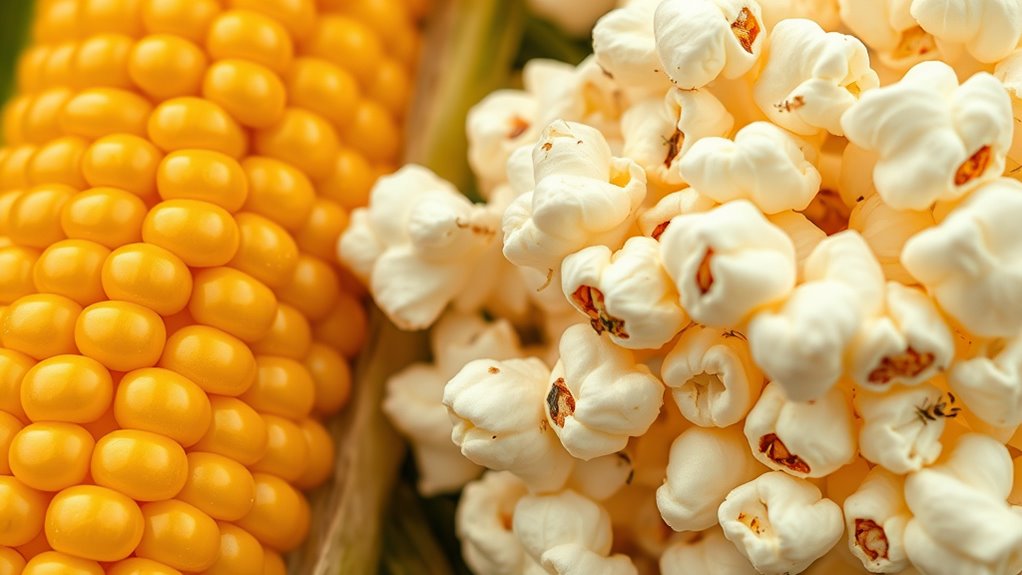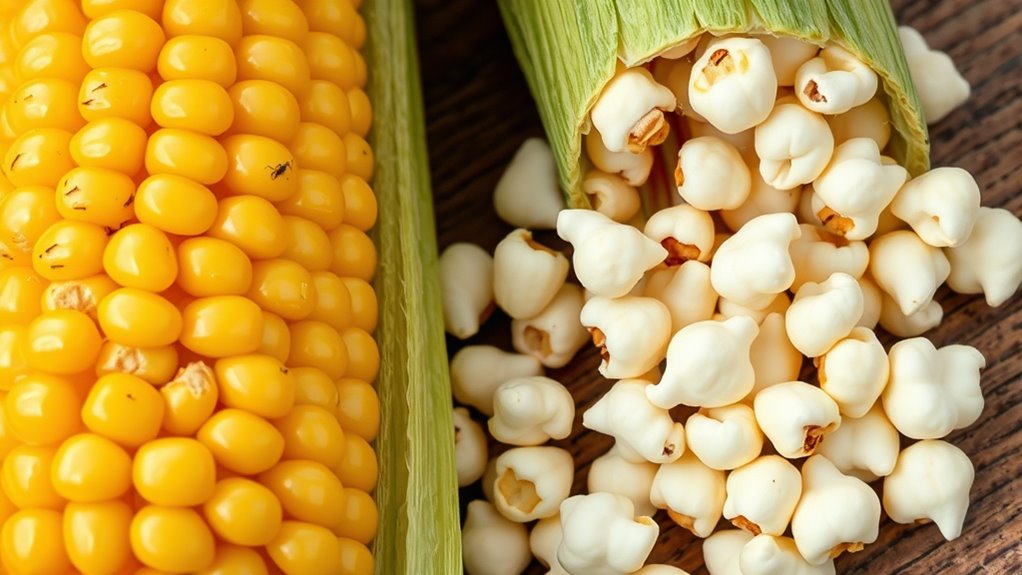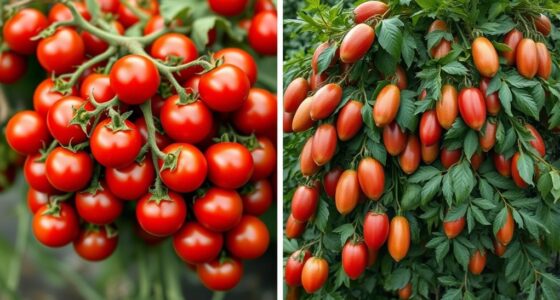Sweet corn is more attractive to earworms and borers, which damage the kernels and stalks, leading to unmarketable ears and plant weakness. Earworms burrow into kernels, ruining the crop, while borers tunnel through stalks, causing potential plant failure. Popcorn is less susceptible because it’s harvested when kernels are fully mature and less appealing to pests. To understand how these pests differ in affecting each type and how to manage them, keep going for more details.
Key Takeaways
- Sweet corn is more attractive and susceptible to earworms and borers than popcorn.
- Earworms burrow into sweet corn kernels, causing unmarketable ears, while popcorn is less targeted.
- Borers tunnel into sweet corn stalks and ears, increasing damage risk; popcorn plants are less prone.
- Pest control is more critical in sweet corn due to higher pest susceptibility.
- Proper harvest timing can help reduce pest damage effects on both sweet corn and popcorn.

Have you ever wondered what sets sweet corn apart from popcorn? The differences go beyond texture and flavor; they also involve how each crop interacts with pests and how carefully you need to time your harvest. When growing either type, pest control becomes a critical factor. Sweet corn is more attractive to certain pests, such as earworms and borers, which can quickly ruin a harvest if not managed properly. Earworms, for example, are caterpillars that burrow into the kernels, making the ears unappetizing and unmarketable. Borers, on the other hand, tunnel into the stalks and ears, weakening the plant and opening the door to disease and further pest intrusion. To keep pests at bay, you need to implement integrated pest management strategies, including crop rotation, proper timing of planting, and possibly organic or chemical controls. Regular scouting is essential, so you can catch infestations early and apply treatments before damage becomes severe. Additionally, monitoring pest populations and understanding their behavior can help you develop more effective control strategies.
Harvest timing also plays a pivotal role in differentiating sweet corn from popcorn. Sweet corn is harvested when the kernels are at the milk stage, which means they’re full of milky fluid and taste sweet. Harvest too early, and the kernels won’t have developed enough flavor; wait too long, and the sugars convert to starch, resulting in less sweet, tougher ears. Precise timing ensures you enjoy the best flavor and texture. Popcorn, however, requires a different approach. It’s typically harvested when the kernels are fully mature and have reached the right moisture content—around 14-20%. The kernels should be hard and dry enough to pop effectively. If you harvest too early, the moisture content will be too high, causing poor popping performance. Conversely, waiting too long can lead to kernel loss or damage from pests.
Both crops demand attention to harvest timing, but sweet corn’s peak quality window is narrower. The moment the kernels reach the milky stage is fleeting, so you need to monitor your plants closely. Pests can complicate this process, as damage caused by earworms or borers can sometimes mimic signs of overripe or damaged ears, making it tricky to decide the right harvest moment. Pest control measures help protect your crop’s integrity, ensuring you harvest at the perfect time for flavor and quality. Proper timing minimizes pest damage and maximizes your crop’s market value, whether you’re growing sweet corn for eating fresh or popcorn for processing. In the end, understanding the pest challenges and harvest timing intricacies helps you produce a healthier, more delicious yield.
Frequently Asked Questions
How Can I Prevent Earworm Infestations in My Corn?
To prevent earworm infestations, you should practice crop rotation to disrupt their life cycle and reduce infestations. Biological control methods, like releasing natural predators or using beneficial nematodes, can also help manage earworms effectively. Additionally, monitor your corn regularly for early signs of infestation, and consider applying appropriate insecticides if necessary. Combining crop rotation with biological control creates a strong defense against earworms.
Are Certain Corn Varieties More Resistant to Borers?
Yes, you can choose corn varieties with better pest resistance traits to reduce borer damage. When selecting seeds, look for varieties bred specifically for pest resistance traits, which often include natural defenses against borers. Your goal should be to prioritize corn variety selection that enhances pest resistance, making it harder for borers to infest your crop. This proactive approach helps protect your plants and minimizes the need for chemical controls.
What Natural Methods Deter Earworms From Corn Crops?
To deter earworms naturally, you can try companion planting with herbs like dill or marigolds, which repel pests. Applying neem oil also helps by acting as a natural insecticide that disrupts earworm development. Regularly inspecting your corn and removing any infested plants further reduces the risk. Combining these methods creates a pest-resistant environment, keeping your corn healthier without relying on chemicals.
How Do Earworms and Borers Affect Corn Yield Quality?
Earworms and borers can considerably reduce your corn’s crop quality by causing pest damage that weakens stalks and kernels. This damage not only lowers the market value but also reduces overall yield. When these pests infest your crops, they compromise the integrity of the ears, making them less appealing and more prone to rot. Managing these pests effectively helps maintain high crop quality and maximizes your harvest’s potential.
Can Earworms or Borers Spread to Other Crops Nearby?
Imagine pests as travelers crossing borders between fields. Yes, earworms and borers can spread to nearby crops through crop proximity, especially if fields are close together or not properly managed. These pests migrate, hitching rides on wind, equipment, or even movement of infested plants. To prevent this, you need to monitor pest activity carefully and maintain buffer zones, reducing the risk of pest migration and protecting all your crops effectively.
Conclusion
Now that you know the key differences between sweet corn and popcorn, you might wonder which pest could threaten your favorite crop next. Earworms and borers hide in the shadows, waiting for the right moment to strike. Will your next harvest be safe, or will these pests surprise you? Stay vigilant, because understanding their habits could be the difference between a bumper crop and a disappointing loss. The battle against these pests is just beginning—are you prepared?









